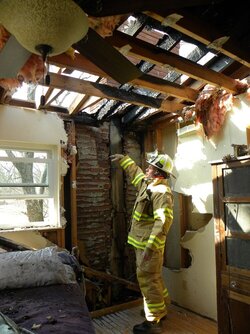Hello all, I suspect my wood burning fireplace is slowly leaking fumes into the house but am unsure as there is never any visible inside smoke. I suspect it is leaking as, after an hour of so, the smell of burning wood starts to appear and a while later, eye and throat irritation start to set in. I have looked carefully for any sign of smoke emanating from the firebox or the stone facia above and can see nothing. There are also no signs of soot blackening anywhere. The CO detector does not show any indication of CO presence.
The setup is an old (circa 1975) Northern Heatliner "heat form" type of prefabbed metal firebox (same idea as the Heatilator stuff) with provision for drawing in outside air around the inner walls and through four heat-exchanger tubes and out the front of the fireplace just above the top of the fire box.. As a test, I have tried blocking that outlet off but no improvement was noted.
The flue is 12x12 clay tile (the orange coloured stuff). I have looked inside as best I can from both top and bottom and can see no apparent cracks or missing material in the box or flue. The fireplace draws well so I don't think that is an issue. There is little evident creosote buildup as I have always used good dry wood and run the fire quite hot. It has a nat gas log lighter so there is little smoke generated at start-up.
I guess my question is, does anyone have some effective method of testing for such slow leak(s). Maybe a smoke generator with the flue capped and the front of the firebox walled off (I actually do have a tight fitting cover for the firebox opening that I use to keep out cold air when it is not being used).
Is there any device that might be useful for small leak detection such as a thermal imaging camera? Or anything else that might work??
I guess the next issue, if a leak is found, is can it be fixed? Access to the flue and the flu/metal box transition from the bottom is quite limited because of the heat exchanger pipes (which run just below the damper).
Thanks for any suggestions - I would really like to avoid having to install an insert or flue liner (if that in fact could be done).
The setup is an old (circa 1975) Northern Heatliner "heat form" type of prefabbed metal firebox (same idea as the Heatilator stuff) with provision for drawing in outside air around the inner walls and through four heat-exchanger tubes and out the front of the fireplace just above the top of the fire box.. As a test, I have tried blocking that outlet off but no improvement was noted.
The flue is 12x12 clay tile (the orange coloured stuff). I have looked inside as best I can from both top and bottom and can see no apparent cracks or missing material in the box or flue. The fireplace draws well so I don't think that is an issue. There is little evident creosote buildup as I have always used good dry wood and run the fire quite hot. It has a nat gas log lighter so there is little smoke generated at start-up.
I guess my question is, does anyone have some effective method of testing for such slow leak(s). Maybe a smoke generator with the flue capped and the front of the firebox walled off (I actually do have a tight fitting cover for the firebox opening that I use to keep out cold air when it is not being used).
Is there any device that might be useful for small leak detection such as a thermal imaging camera? Or anything else that might work??
I guess the next issue, if a leak is found, is can it be fixed? Access to the flue and the flu/metal box transition from the bottom is quite limited because of the heat exchanger pipes (which run just below the damper).
Thanks for any suggestions - I would really like to avoid having to install an insert or flue liner (if that in fact could be done).


